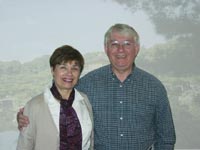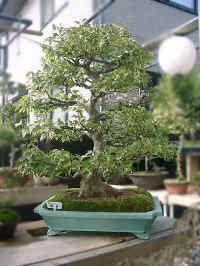 Page 1 2 3 4 5 6 7 8 9 10 11 12 13 14 15 16
Wednesday, 30 October. We were up before 7:00 and finished packing. We had
arranged for a taxi to come by and take us to the Heizan-Sakamoto station at 11:10. We intended
to catch the 12:18 Hikari train to Osaka's Kansai Airport, but it was canceled. So, after thanking
Tom and Kyoko for their hospitality, we took the 12:48 train instead. For lunch we ate
sandwiches on the train. We got to the airport at 2:02, in plenty of time for our 3:45 flight.
The United flight left on time. There was a view of distant Mt. Fuji soon after takeoff. Except for patches of bumpy weather, the flight was uneventful. We touched down in San Francisco early, at 7:45 a.m. It was still Wednesday because we'd crossed the International Date Line. We had to claim our luggage and go through customs and immigration, but that was quick. With a layover of nearly four hours, we had plenty of time. The flight to Washington Dulles left promptly at 11:35, and we arrived at 7:00 p.m. We took the shuttle to the Fairfield Inn where we picked up our car. We got home a little after 10:00 and were in bed by 11:00 p.m. That would have been 1:00 p.m. Thursday in Japan. It had been almost 31 hours since we got up that morning. General Observations. Because this trip was primarily a family visit with Tom and Kyoko, it's hard to compare it to our other overseas trips. Although we did a lot of sightseeing, it was mostly for only a few hours at a time. That certainly is a more enjoyable way to do it than being on the go all day, every day. Not only did we see a lot, but we did things that ordinary tourists wouldn't have a chance to do (like visiting with Tom's friends). It seemed to us that Japan catered less to foreign tourists than most other foreign countries we've visited (but not less than the U.S.). Probably less than half the attractions we saw had signs in English. A few more had brochures with at least some English. But many had neither. That may be because we visited several places that don't have many Western visitors. The better-known attractions did have English signs and/or brochures. Of course, language is always a special problem in a country that doesn't use the Roman alphabet (called romaji in Japan). The fact that Tom and Kyoko were with us most of the time minimized this problem for us, but tourists on their own would likely have problems when so few signs, menus, guides, etc. use the Roman alphabet. It's often said that "most" Japanese speak English but, in our limited exposure, we did not find that to be the case. We found the somewhat formalized social politeness very nice. We could use more of that in the West. (Unfortunately, though, the Japanese teenagers seem just as rude and thoughtless as they are in the U.S. and Europe.) The custom of giving token gifts on many social occasions also has a certain charm. We even received a gift (and a nice one) from a neighbor of Kyoko, someone we never did meet. Everyone has heard that you take your shoes off upon entering a Japanese home, so that custom didn't surprise us. (Jane is all in favor of this practice and would like to see it adopted in the U.S.) We didn't realize, though, that it extends to so many other buildings, too. That's certainly understandable with regard to old buildings with fragile floors or those with tatami mats. But the same custom is enforced in many large, modern museums with terrazzo floors. From what I'd read before our trip, I was never clear on what religion is more popular in Japan, Buddhism or Shinto. From my observations there, I now would say that my question was too simplistic. Tom quoted us a saying that the Japanese are born Shinto and die Buddhist. While that, too, may sound simplistic, if you stop to analyze it, that saying may provide the answer. Since every living Japanese is somewhere between those milestones (birth and death), they are also somewhere between Shinto and Buddhism, at least a little in each camp. The Japanese clearly have an exceptional love of natural beauty. This is evidenced by their lovely gardens. In Western gardens, we usually see a flat, often geometric, design with fountains, arrays of flowers, and other displays that aren't found in nature. Japanese gardens usually feature trees, rocks, small lakes, streams and waterfalls laid out in a seemingly random way to follow the contours of the site. Nearly every Japanese home has some sort of garden, though parking for cars has usurped much of the space previously given to home gardens. Some homes have only a foot-wide strip running across the front of the lot, but even these are beautiful and well-tended. And their skill at flower arranging is well known. In one historic house we visited, there was a tall vase containing a crooked dead tree branch, a smaller branch with green leaves, and a single red flower. The effect was striking, but few Westerners would even think of combining such elements. This different sense of beauty apparently once prevailed in architecture as well. Although most modern buildings are Western in style, or close to it, the older buildings show a very distinctive approach. The palaces and large homes were remarkably simple in their design and construction. The exterior walls were usually of plain, dark wood, sometimes brightened up by plain panels of white or tan stucco. Rarely, there might be a few pieces of brass trim along the gables. Only three months before coming to Japan, we had been in Russia, with its many ostentatious baroque palaces, making the contrast even more stark. The interiors of the old Japanese palaces and houses also were very simple. To preserve this clean, simple look, there usually were closets in every room where the furniture would be hidden when not being used. All in all, it was a very enjoyable trip. We were a little disappointed that we didn't get to see the maple trees in their full colors. To do that, though, we would have to have been there well into November. As it was, the weather turned mostly cool and cloudy less than half way through our stay. We enjoyed those several days of very pleasant weather.
Copyright © 2000-2023 DarrellPeck.com All rights
reserved. | ||

